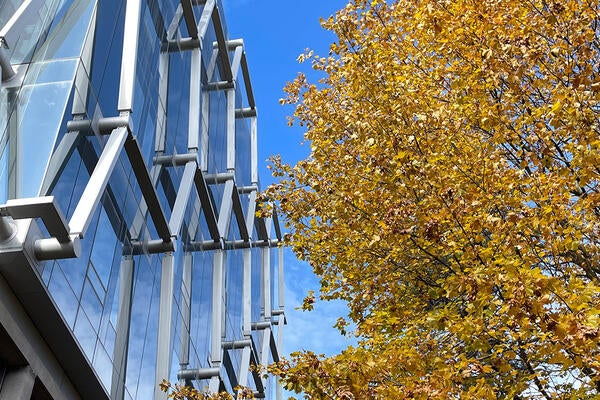
School of Architecture hosts international conference
Researchers are developing sustainable smart buildings that may one day be like living organisms, says Waterloo prof

Researchers are developing sustainable smart buildings that may one day be like living organisms, says Waterloo prof
By Carol Truemner Faculty of EngineeringInnovative sustainable design is showcased in Cambridge this week as architects from throughout the world gather at Waterloo’s School of Architecture for the Association for Computer-Aided Design In Architecture (ACADIA) 2013 Conference.
Entitled Adaptive Architecture, the international conference held in cooperation with the University of Waterloo, University of Buffalo, SUNY and the University of Nottingham, highlights the latest developments in computational design of environmentally responsive, intelligent, interactive and reconfigurable architecture.

Philip Beesley demonstrates one of the adaptive designs from his recent exhibition, Radiant Soil.
“The ‘adaptive’ topic that focuses this year’s gathering has potent implications for architecture,” says Philip Beesley, a Waterloo architecture professor and the chair of Acadia 2013. “Architectural designers and researchers are increasingly working with extremely complex systems of interactive ‘intelligent’ components and assemblies. Some designs are even starting to emulate the self-renewing qualities of living organisms, integrating porous membranes, thermal exchangers and chemical circulation systems.”
More than 300 participants, including researchers, creators, technical experts, international research team members, and students are expected to attend the October 24-26 conference that Beesley describes as offering some of the most important research in the world on new architectural design.
“Teams are coming from Australia, Denmark, Switzerland, Germany, Britain, and across the United States and Canada. Exhibits are also being sent from China and New Zealand,” says Jessica Owens, a School of Architecture exchange student from Australia and Waterloo’s press and promotion coordinator for the conference.
Open to the public, the exhibit and installations that cover the floors and walls of the entire school and the Design at Riverside gallery feature the major European show Prototyping Architecture, Tex-Fab SKIN, Making it Real, and Objet 3D. Keynote speakers include design experts Michelle Addington of Yale University, Cristiano Ceccato of Zaha Hadid Architects, and Stephen Gage of the Bartlett School of Architecture, University College London.
In addition, late-night music and projection events will be staged in a warehouse space across the river in the heart of Cambridge. Also scheduled are tours of North House, the solar decathlon entry which was designed and built primarily by Waterloo architecture students and faculty members.
“The opportunity to host this event is providing Waterloo's School of Architecture with a number of things starting with international exposure as part of the architecture community,” says Owens. “It is the ideal place to connect architects from all levels of practice.”

Read more
Here are the people and events behind some of this year’s most compelling Waterloo stories

Read more
15 University of Waterloo researchers have been named to the annual Highly Cited Researchers™ list for significant contributions to their specific fields of research

Read more
New Canada Research Chairs will tackle future-focused problems from social robots and intergroup attitudes to geochemistry and nanoscale devices
The University of Waterloo acknowledges that much of our work takes place on the traditional territory of the Neutral, Anishinaabeg, and Haudenosaunee peoples. Our main campus is situated on the Haldimand Tract, the land granted to the Six Nations that includes six miles on each side of the Grand River. Our active work toward reconciliation takes place across our campuses through research, learning, teaching, and community building, and is co-ordinated within the Office of Indigenous Relations.